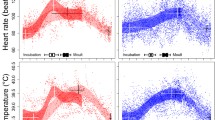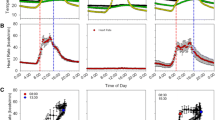Abstract
Group-hibernating Alpine marmots maintain close body contact to other group members during both deep torpor and euthermic intervals. Analyzing telemetrically recorded body temperature (Tb) profiles of 64 free-living marmots we found that rates of heat loss were independent of individual body mass. Serial correlation coefficients for pairwise comparisons of Tb patterns indicated that the time course of changes between torpor and periodic arousals was generally well synchronized within groups, with territorials arousing significantly earlier than other group members. The degree of group synchrony was the most important factor influencing winter mass-loss. However, group synchrony was impaired in the presence of juveniles. Juveniles frequently displayed delayed warm-ups and appeared to passively gain heat from close body contact to warmer adults. While reduced group synchrony is disadvantageous for adults, it can be calculated that juveniles have a net energetical benefit .
Access this chapter
Tax calculation will be finalised at checkout
Purchases are for personal use only
Preview
Unable to display preview. Download preview PDF.
Similar content being viewed by others
References
Arnold W (1988) Social thermoregulation during hibernation in alpine marmots (Marmota marmota). J Comp Physiol B 158, 151–156
Arnold W (1990a) The evolution of marmot sociality: I. Why disperse late? Behav Ecol Sociobiol 27, 229–237
Arnold W (1990b) The evolution of marmot sociality: II. Costs and benefits of joint hibernation. Behav Ecol Sociobiol 27, 239–246
Arnold W (1993) Energetics of social hibernation. In: Carey C, Florant GL, Wunder BA, Horwitz B (eds) Life in the Cold: Ecological, Physiological, and Molecular Mechanisms, Westview Press, Boulder, pp 65–80
Arnold W (1995) Social behaviour and telemetric assessment of thermoregulation in hibernating marmots. In: Alleva E, Fasolo A, Lipp HP, Nadel L, Ricceri L (eds) Behavioural brain research in natural ist ic and sem i-natural ist ic settings, Kluwer, Amsterdam, pp 395–411
Arnold W, Klinkicht M, Tautz D(1993) Molecular analysis of the mating system of alpine marmots (Marmota marmota). Verh Dtsch Zool Ges 86, 27
Bibikov DI (1989) Marmots. Agropromisdat, Moscow
Goossens B, Graziani L, Waits LP, Farand E, Magonolon S, Coulon J, Bel MC, Taberlet P, Allaine D(1998) Extra-pair paternity in the monogameous Alpine marmot revealed by nuclear DNA microsatellite analysis. Behav Ecol Sociobiol 43, 281–288
Hackländer K, Arnold W(1999) Male-caused failure of female reproduction and its adaptive value in alpine marmots (Marmota marmota). Behav Ecol Sociobiol 10/5, 592–597
Heldmaier G, Ortmann S, Körtner G(1993) Energy requirements of hibernating alpine marmots. In: Carey C, Florant GL, Wunder BA., Horwitz B (eds) Life in the cold: ecological, physiological and molecular mechanisms, Westview Press, Boulder, pp. 175–183
Herreid CF, Kessel B (1967) Thermal conductance in birds and mammals. Comp Biochem Physiol 21,405–414
Ortmann S(1997) Strategien der saisonalen Anpassung beim Alpenmurmeltier (Marmota marmota L.). PhD thesis, Biology Department, Philipps-Universität, Marburg
Ruf T (1992) Torpor beim Dsungarischen Zwerghamster (Phodopus sungorus) und der Hirschmaus (Peromyscus maniculatus). PhD thesis, Biology Department, PhilippsUniversität, Marburg
Sokal RR, Rohlf FJ (1995) Biometry: the principles and practice of statistics in biological research, 3d ed. W.H. Freeman and Company, New York Oxford
Wang LCH (1978) Energetics and field aspects of mammalian torpor: the Richardson’s ground squirrel. In: Wang LCH, Hudson JW (eds) Strategies in the Cold, Natural Torpidity and Thermogenesis. Academic Press, New York, pp 109–145
Author information
Authors and Affiliations
Editor information
Editors and Affiliations
Rights and permissions
Copyright information
© 2000 Springer-Verlag Berlin Heidelberg
About this paper
Cite this paper
Ruf, T., Arnold, W. (2000). Mechanisms of Social Thermoregulation in Hibernating Alpine Marmots (Marmota marmota). In: Heldmaier, G., Klingenspor, M. (eds) Life in the Cold. Springer, Berlin, Heidelberg. https://doi.org/10.1007/978-3-662-04162-8_9
Download citation
DOI: https://doi.org/10.1007/978-3-662-04162-8_9
Publisher Name: Springer, Berlin, Heidelberg
Print ISBN: 978-3-642-08682-3
Online ISBN: 978-3-662-04162-8
eBook Packages: Springer Book Archive




